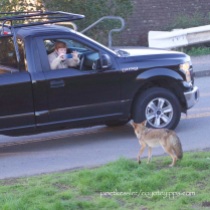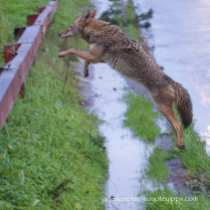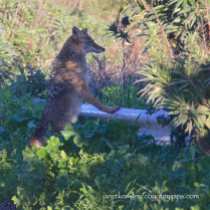UrbanCoyoteSquared: GALLERIES
Here are some photos showing instantaneous slices of urban coyote life: the most urban-saturated part of it. Although most coyote activity is below our radar, some of it, both in the parks and beyond the parks is there to be seen.
My photos are for everyone’s use as long as you ask permission, give me credit and tell me where you’ve put it/them. I can dig up larger files if you need them.
There are three galleries here: by clicking on any of the photos, the photo will become enlarged, and then you can scroll through all of them, within each of the three galleries.
What is “harassment” of wildlife? Harassment is involved if you cause a coyote to change it’s natural behaviors in any way: coyotes are harassed by feeding them and especially hand-feeding or feeding from cars. Another harassment is allowing your dog chase them. These human behaviors condition coyotes to approach individual people and their dogs, and to hang around the areas which humans tend to frequent. Humans have harassed them in other ways: by shooting them with paintball guns (there’s an image below showing this), by tagging and collaring them (yep — we tend to “accept” that scientists are justified in what they do, but we need to question it). But they are also harassed by other coyotes in territorial battles and even by ravens! Simply watching coyotes does not harass them unless you cause their behavior to change.
TRIAL PHOTOS: Note that none of the coyotes in these photos is approaching people. However, the above FED coyote hung around the area where she had been fed: she approached cars and sometimes stopped and seemed to looked imploringly at walkers-by. The coyote in the gallery below was not fed regularly as far as I ever saw, however, there were occasional reports of chicken or dog food left out as time went along. I always felt that a human might have raised her because she allowed closer proximity than normal without bolting and fleeing as you can see in the photos below — but she never just hung around. When she encountered people, or people and their leashed dogs, normally along trails which the coyotes also used, both stopped to observed each other and then walked on in opposite directions. During the time-frame when her dog enemies walked, she would perch up on a hill and watch for them: she was keeping track of them and making sure that they eventually left.
Leashed dogs seldom if ever created issues for either of these two coyotes, and the same for calm dogs off leashes next to owners. But dogs who chased the coyotes created problems, or even lunged and barked at them regularly did, and the coyotes always remembered who they were, and kept an eye open for them, and were ready to let the dog know this. This is where the problems have always been: with unleashed dogs in their areas. Guidelines for stewardship and coexistence are very simple and are listed in the three last photos in the third gallery at the bottom of the page. Please help spread this information to your friends and neighbors! Janet













































AND MORE:






















































PS: I use a 650mm lens and crop extensively — the below photo was taken at a distance of about 80 feet, zoomed-in, then cropped, then cropped again.


















Again, “Wildlife harassment means to engage in any act which demonstrates a disregard for the well-being of wildlife or which creates the likelihood of injury to, or disrupts normal behavior patterns of wildlife, such as feeding, watering, resting, and breeding. Such acts include, but are not limited to chasing, pursuing, herding, or attempting to take wildlife. It includes the feeding, touching, teasing, frightening or intentional disturbing of wildlife.” If a coyote comes to close to me, I walk away from him/her, and I recommend others do the same, especially if they have a dog. However, simple proximity to a coyote, as seen in these photos above, does not constitute harassment. Coyotes get used to their environmental situations, and urban environments include lots of people using their same spaces.


































































Nov 08, 2017 @ 06:04:49
Wow!!! Amazing photos. Some really beautiful and intimate shots. Thank you for creating deep connections with Coyote and sharing them.
Nov 11, 2017 @ 19:57:48
Thank you, Cindie! Janet
May 11, 2020 @ 03:09:24
Hi! I live in a relatively remote area of Kansas that is an expansive grazing area that has a significant population of coyotes. What I think is a pair of coyotes are having interesting interactions with my 80 lb dog that is half doberman and equal parts of german shepard, wolf, malamute and husky. She is a large athletic dog. Five acres of my property is enclosed by invisible fence so to keep my dogs home. When the coyotes drop by my dog runs toward them barking with her back up. She can only go up to the edge of the fence so the interaction is limited geographically. The coyotes respond with their backs up and typically stand their ground or move off a short distance until my dog turns and goes back toward the house. Regularly one of the coyotes will go under the barbed wire fence to follow her for awhile until my dog turns back and runs towards them. It appears to be some sort of territorial dance. The coyotes do not seem particular aggressive or scared perhaps because they have determined the dog can not go further. They will do this repeatedly until I call my dog home.
Last year we had an adolescent (I think) coyote that would trot through the paths that are mowed in the very tall native grass yipping. He would go a little while and yip, a little further and another yip. The coyotes have tended to be silent here unless they are howling. The first time I heard it I thought that it was an injured dog. I have lived out here for 30 years and that was the first for that. It happened regularly enough that we referred to him as Yippy.
I would be interested in a recommendation for a book or two on coyote behavior because this is fascinating. I know there is something being communicated and I would like to know what. Thanks in advance for your recommendations and for your great web page. Coyotes and wolves get a bad rap.
May 11, 2020 @ 19:03:45
Hi Patricia —
Actually, the most complete information you are going to get is from this blog. For starters you could watch my presentation: https://youtu.be/mr8XmM1bi70. There’s a posting on “voicings” or vocalizations which you mention in your comment, and plenty of information of coyotes and dogs. If you have particular questions, please feel free to ask. Without being there to see exactly what is going on, I can’t really assess why “Yippy” is vocalizing this way. Also, each coyote is different and may come up with their own way of coping with the stress of having dogs charge towards them in that area. Then again, the fella may simply be testing, provoking, your dog who, so far, stops short at an invisible fence-line.
Dec 12, 2020 @ 20:02:54
Hi, The Richmond Nature Park (in BC, Canada) is planning to launch a series of virtual nature programs to students in classrooms and at home. One program, which is called, “Now You See Them Now You Don’t”, is about exploring seasonality on the west coast featuring adaptations of Coyotes and Snow Geese. While researching coyote images, I came across your website. What a find – so much information presented in an engaging manner. Your enthusiasm and love for the subject really shine.
There are four photos of yours that we would like to use for our program. They are all posted on your Oct 31, 2014 entry: the top two photos showing Winter Markings and Summer Coat, and the two below those on the right showing Part Sumer and Part Winter Coat and Full Thick Winter Coat. We would like to have them in their original format if possible as the presentations will probably be projected onto large screens in classrooms. We would, of course, give you proper credit as requested on your website.
I was also wondering if you could tell me if these coyotes would be the same sub-species as the ones we have in the Vancouver area of BC?
Thank you so much for your time and effort in putting together your website,
Sincerely,
Gloria Hollinger
Dec 12, 2020 @ 20:21:55
Hi Gloria —
I’m so glad you like the site! Thank you for all your compliments! You are welcome to use any photos you want, but I would like credit, which you have offered, so thank you. I could not find any photos posted on October 31, 2014, if you need larger files, we’ll have to zero in on which photos you are talking about. I know there are 19 sub-species of coyotes, running in size from the 65 pound Eastern Coyote (often called the Coywolf) to the small 15 pound variety found in Florida. Ours here on the west coast are called Western Coyotes, and they weigh between 25 and 32 pounds. I’m sorry that I can’t tell you if they are the same subspecies in Vancouver. I would think, because of the vast distances, that they would be different, but I do not know this. Okay, please let me know about the larger files. Janet
Dec 12, 2020 @ 21:59:10
Thanks for being so generous with your time. I would like the larger files if possible.
Here’s the link: https://coyoteyipps.com/category/coyote-physical-appearance/coyotes-coat/#:~:text=Coyotes%20have%20a%20signature%20winter%20coat%20%28photo%20above,in%20size%2C%20intensity%20of%20colors%20and%20color%20combination.
I see the photos on the the third post on the page.